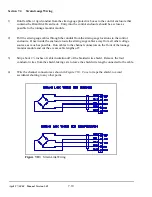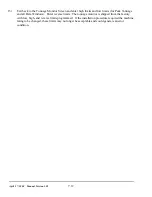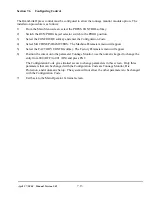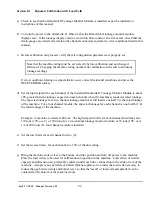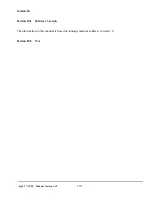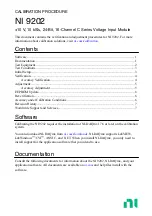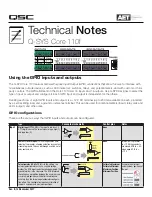
April 27, 2004 Manual Version 1.01
8.7
Section 8.3
Replacing System 1000/1100
If the OmniLink II Tonnage Monitor Module is replacing a System 1000 or System 1100 Tonnage
Monitor that is already installed on the machine and calibrated, the calibration numbers from the System
1000/1100 can be transferred to the OmniLink II. This is done by accessing the configuration menus of
the OmniLink II Tonnage Monitor Module and selecting Calibration and Channel Descriptions. With the
RUN/PROG keyed selector switch in the PROG position multiply the calibration number from the
System 1000/1100 for channel 1 by 1.11 and enter this value into the Cal.# for channel 1 of the OmniLink
II. Repeat this procedure for each channel.
Section 8.4
Calibration Numbers
The channel calibration number of the OmniLink II Tonnage Monitor Module is a direct reflection of the
analog gain on that channel.
A Cal.# of 200 = Gain of 20.0
The calibration number for a System 1000 or System 1100 Tonnage Monitor is proportional to gain but
not equal to it. This means that transferring the cal. number from a System 1000/1100 to a OmniLink II
requires that the number be multiplied by a constant (constant=1.11).
Cal.#(OmniLink II) = Cal.#(System 1000/1100) * 1.11
Section 8.5
Incorrect Tie Rod Tension
Straight side machines of tie rod construction are designed for tie rods to be in tension such that the bed
and crown or the machine are held to the uprights (columns) with a force of from 150% to 200% of rated
machine tonnage. The tension forces in the tie rods produce equal compression forces in the uprights.
When strain gauges are mounted on uprights, the tonnage exerted by the machine tooling stretches
(strains) the tie rod by an amount proportional to load and releases the compressive forces in the uprights
proportional to load. If the tension on a tie rod places a compressive force on the upright that is less than
the force released by the load, all compressive force will be removed from the upright, and the signal
from the strain gauge on the upright will no longer be proportional to load.
This condition can be detected during calibration of a straight side machine when strain gauges are
mounted at approximately the same location on the uprights. If, at rated tonnage, the calibration number
associated with one or more channels must be much higher than the other channels in order to produce
equal tonnage readings, improper tension in the tie rod may exist. To determine if tie rod tension is the
actual cause, reduce the load on the load cells during calibration until the sum of the load cell tonnages is
equal to about 1/4 of rated machine tonnage, while making sure that approximately equal loads are on the
load cells. If the channels with much higher calibration numbers now give tonnage readings much larger
than the channels with lower calibration numbers improper tie rod tension is indicated.
Summary of Contents for OmniLink II
Page 5: ...April 27 2004 Manual Version 1 01 iv ...
Page 7: ...April 27 2004 Manual Version 1 01 1 2 ...
Page 21: ...April 27 2004 Manual Version 1 01 3 8 ...
Page 44: ...April 27 2004 Manual Version 1 01 4 23 Section 4 5 4 N A ...
Page 45: ...April 27 2004 Manual Version 1 01 4 24 ...
Page 69: ...April 27 2004 Manual Version 1 01 7 14 ...
Page 77: ...April 27 2004 Manual Version 1 01 8 8 ...




